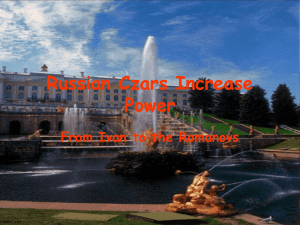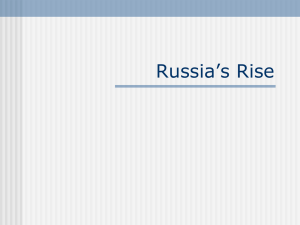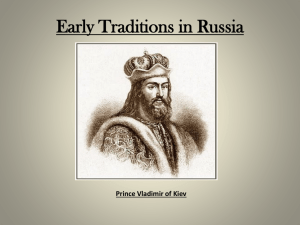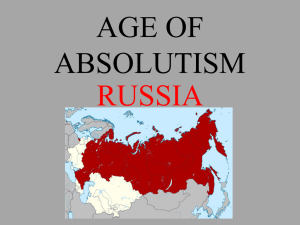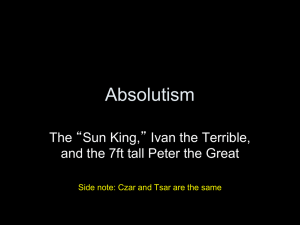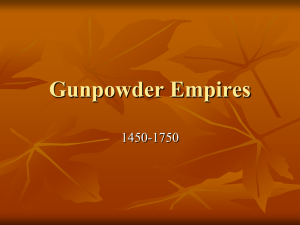Russia 1450-1750 - White Plains Public Schools
advertisement
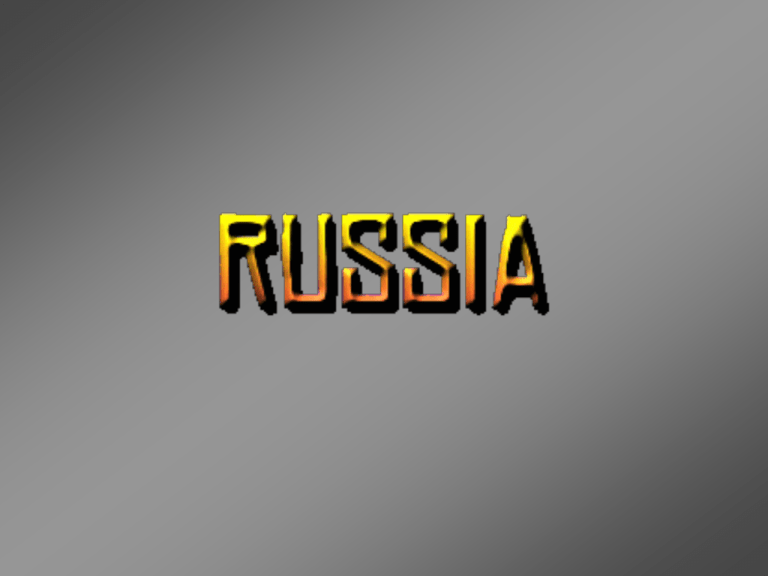
• • • • Kiev – established by Vikings Strong Byzantine influences Conquered by Mongols in late 1230’s Princes of Muscovy worked with Mongols to gain power • Ivan III (the Great) stopped tribute to Mongols in 1480 • Ivan III established strong centralized government • Married niece of last Byzantine emperor – took title of Czar (Tsar) • Adopted Byzantine double-headed eagle as state emblem • Adopted pomp and ceremony of Byzantine court – called Russia “Third Rome” • Ivan III absorbed independent Novgorod (tied to Poland-Lithuania) into new state • To settle new territories, Ivan III used free peasant pioneers (Cossacks) • Cossacks played large role in the expansion of Russia • Focus of expansion was to the east - Furs The Cossacks The Growth of Russia from 1300 to 1584 • Russia- Early Contact with the West Western merchants established trade contacts Italian artists & architects imported for royal and church buildings Russia looked to the West as example for court life Russia selectively copied Western culture / commerce • Competition with nobility (Boyars) for power • Czar took on role as head of church • Struggle with Boyars reached climax under rule of Ivan IV Ivan IV • Ivan IV (Ivan the Terrible) Began rule at age 16 Married into Romanov Boyar clan Suspected Boyars of killing his wife Threatened to abdicate unless given power to deal with Boyars and gain land called Oprichnina (“land apart”) • Ivan IV broke up estates of Boyars • Created new aristocratic class called Oprichniki • Used Oprichniki to terrorize population • Depredations made Russia weak – open to outside invasions • Ivan turned on Oprichniki • Ivan IV died (1584) leaving no heir • Civil War ensued along with outside invasions • Mikhail Romanov elected Czar in 1613 • Romanovs would rule to 1917 Ivan cradles his dead son • Peter the Great Peter developed fascination for Western technology Took throne in 1689 Established a policy of rapid and forced modernization and Westernization Copied many aspects of Western military Peter the Great Established the “Table of Ranks,” permitting nobles to move ahead based on merit Abolished the Terem, the Russian equivalent of the harem Encouraged the mixing of the sexes in towns and cities 1703 - built new capital on the Baltic Sea, St. Petersburg • Russia and the West Peter adopted only that which did not interfere with the autocratic state Westernization caused hostility on part of the populace Russia would continue love-hate relationship with the West • Catherine the Great Married Peter III Peter murdered – Catherine succeeded to throne as Catherine II (1762 – 1796) Ruled with support of nobility and military Selective Westernization – interested in the Enlightenment Catherine II (the Great) Continued expansion of Russia into the Crimea and Siberia Partitioned Poland – Poland not free again until 1918 Absorbed large Jewish population Enacted harsh policies on treatment of serfs Russian Expansion 1700 to 1741 • Expansion east brought contact with Ottomans and Safavids • Took control of Georgia, Azerbaijan, and Armenia • Cossacks conducted campaign against ethnic peoples of Siberia (American west?) Russia COT 1450-1750 • In Russia 1450-1750, the centralization against the Mongols led to the development of the absolutist monarchy of the tsars and the “Westernization” campaign of gaining territory including the essential warm water ports. Feudalism, however, would be increasingly cemented by Russian forces to gain furthered agricultural productivity. • Labor Serfs could be bought and sold A law code in 1649 imposed rigid caste-like structure over Russia’s labor force It restricted both their occupational and their geographical mobility Artisans and merchants had to register their children into their father’s occupation It also established a hierarchy of nobles, making 52 Boyar families the top class Industrialization began under Peter the Great Factory owners could buy serfs, prostitutes, beggars, criminals, and orphans Despite the emphasis put on industry, Russia’s factories never rivaled those of Europe Russia COT 1450-1750 Changes Continuities St. Petersburg (Window to the West) warm water port Tsars centralized Absolute authority Women interacting with men in cities, removal of Tarem, Catherine enlightened despot Westernization campaign- removal beards, development of gunpowder weaponry, table of ranks, first navy Campaign of “eastward” imperialism by Cossaks led to destruction of indigenous populations Moscow still politically, economically and culturally important Role of Orthodox church Still patriarchal Harsh punishment of serfs Jews in pogroms feudalism persitsed Still predominantly agricultural Furs still important revenue
